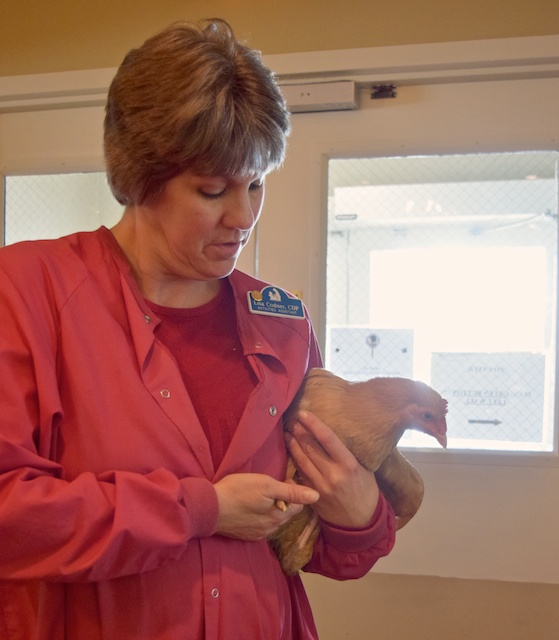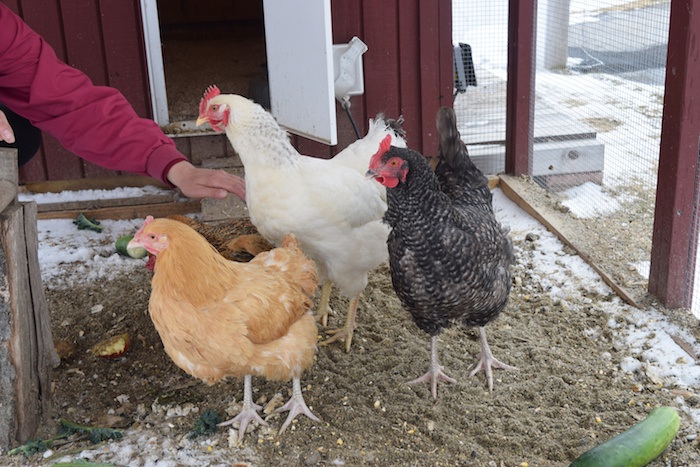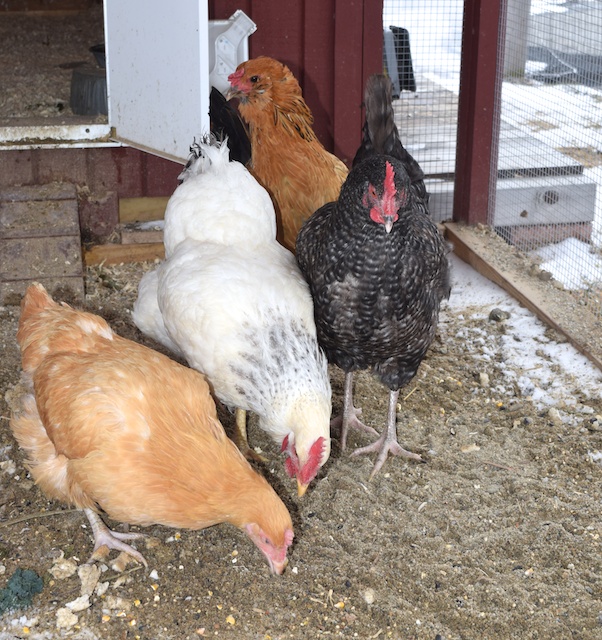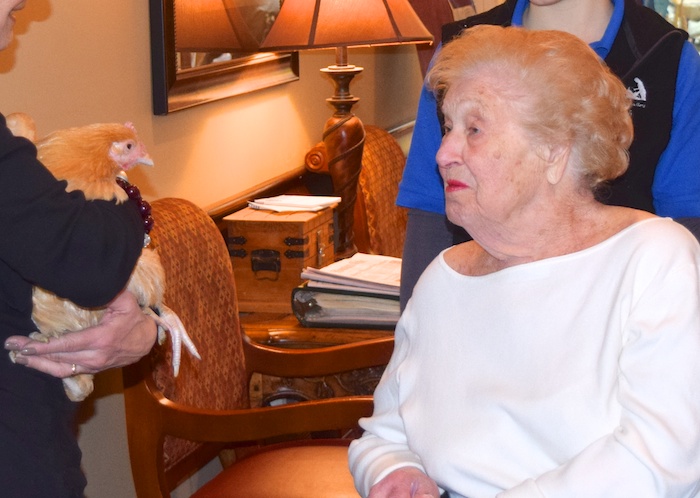(Start at the beginning of this saga of internal laying, here.)
After a full week of TLC, practical remedies and careful observation, Clementine was ready to go back to the nursing home flock. She was still skinny. Her keel bone was as sharp as a knife. She’d always have a bottom weighted down with solidified egg masses, so it was unlikely that she’d be able to hop onto a roost. But, a laundry room is no place for a hen. Besides, her people missed her.
But, inside of a nursing home is no place for a hen to live, either. Clementine had to rejoin her flock.
When a hen is removed from a group and time has passed, say, five days (which is an eternity in a chicken’s mind) the flock does not welcome her back. Never. Ever. They will chase. They will peck. They might draw blood, and sometimes even kill. When you first put a hen back and see the mayhem, your first reaction is to want to pick up and protect the hen that you recently spent so much effort nursing back to health. Don’t. Do not, in your misguided kindness, relegate the hen to a loner’s life. Do not use the flock’s behavior as an excuse to make a house chicken out of her! The returning hen can and must be reintegrated into the flock.
The first thing to do is to make sure that the coop and run are ready for her. Your coop should meet all of the basic criteria – plenty of space, sunlight (the hens need to see inside of the coop!), outside and inside roosts, etc. If the space is cramped, then a hen can be cornered and injured. Fill the feeder and waterer. If the ground is hard and frozen, provide sand for scratching.
When I brought Clementine back to the nursing home, the hens were surprised to see her. They had to think about it. They eyeballed her, and then looked away. Although Clementine was familiar to them, she was changed, too. Chickens don’t like change. Clementine moved differently than the pre-internal laying Clementine. Chickens are concerned about status, and as far as they were concerned, she was now the “new” hen and they needed to know how she fit in.
Clementine was wary, but she was also so happy to see dirt and things to peck. As I said, a laundry room is no place for a hen.
To determine status, there’s often chasing and pecking, which can get brutal if left unchecked. We gave the hens something interesting to divert their attention – a cucumber. For awhile, the cucumber was more interesting than the new hen.
When integrating a hen into an established flock, wait and observe. Behavior unfolds over time. The new hen will be attacked, usually by one chicken at a time. Gently discourage this by stepping between the two, or holding out your hand. Do not hit. Do not yell or chase. Simply interrupting the behavior will achieve what you want.
Because Clementine will always be the weak hen, the others will shunt her off to the fringes of their society. Honestly, that doesn’t matter to a hen. As long as she isn’t physically injured, she’s fine with her life of low status. I watched to make sure that Clem was capable of walking away from aggressive posturing. When another hen snaked a beak at her to peck, Clem stepped aside. I watched for about 15 minutes, occasionally intercepting dominance behavior. All seemed fine. I left.
About fifteen minutes after settling in at home I got a panicked phone call. Clementine was being attacked. LIsa had scooped her up and was carrying her around, protecting her, but she had to leave work. What to do? I drove back.
There was a bitter cold wind, and temperatures hovered at freezing. I took Clementine from Lisa, and put her back in with the hens. Lisa watched anxiously. The Delaware pecked at Clem’s head. Without intervention, this could lead to serious injury. But, too much intervention, and the hen would never be able to rejoin the flock. I stepped in and the Delaware turned away. I stayed for almost an hour. At one point, Clementine hid in a nesting box, (in this coop, there are three on the floor) with her tail to the group. This is a smart move, as they can’t hurt her when she’s in that position. She’s also boring to them like that, and they leave her alone. The first time that she got up to eat, they chased her back. I let this happen. I knew she’d be safe. About ten minutes later, Clementine got up to eat again and they left her alone. It was getting dark and the hens were going inside to roost. I could go home.
In the morning I got another call. Clementine was still being pecked at. It was a sunny day, and so I told them to put her in the fenced yard next to the run. Clem was given food and water. The flock could see her but not get at her. She could see them. Chickens get bored easily. Clementine was now not worthy of their attention. The flock had better things to do than to expend their energy posturing and threatening the yellow hen. They went about their business. At roosting time, Clementine was put back in with the hens.
The next morning, everyone got along.
The lesson here is that returning a hen to a flock is not a matter of simply putting the chicken back in with her old friends. Time away changes everything, and there will be behaviors that can upset you, and potentially harm the bird. BUT, the hens are not being mean. They are being chickens. The hen that you nursed back to health is also a chicken. You have to let them sort things out – while creating safe parameters for the behavior. Do not give up. Do not avoid reintegration because you don’t like seeing the chickens do what chickens do. That said, there is a difference between pecking and pummeling. Allow the squabbling but prevent bloodshed. Gentle dissuasion, a fence, and a cucumber is all that it takes.
It’s been two weeks since Clementine has been returned to her flock. I’ve checked in with her people who tell me that Clem has been accepted by the other chickens. There’s no pecking with contact. She’s able to eat and drink and go about her day. Clementine will always have compromised health, but for now, she leads a good chicken life of dust baths and scratching and breathing fresh air, while also doing the work that this hen is so good at.
UPDATE: Two weeks after Clementine returned to the nursing home, she passed away peacefully in her sleep. I was not surprised, but it was sad news. I did a necropsy, which confirmed my diagnosis of internal laying. It was the worst case that I have ever seen. Her body cavity was packed with masses of egg material. There was also a solidified egg with a soft shell stuck high up in the reproductive tract. It had obviously been there a long time. I believe that eggs formed, were blocked by that stuck egg from making their way down and out, and so instead backed up and fell into the body cavity. By the time Clementine showed signs of distress, this had all been going on for a long time. It’s amazing that she revived as she did. The necropsy also showed that she was eating fine, and that the rest of her systems were working, which illustrates how a chicken can continue to live despite gross abnormalities inside of her. That means that it is our responsibility as their caretakers to make the right decisions. Clementine did revive. She was able to behave as a chicken does, eat, drink, and be part of a flock. If any of those things had changed before she passed away, it would have been a kindness to euthanize her. But, I’m glad that she had those last two weeks.







Yeah for Clementine!! and thank you again Terry for all your caring, balanced with words of wisdom about the health and habits of chickens. So helpful for us chicken lovers.
So sad Clementine has health issues, but I’m happy she is better and rejoined her flock to entertain the residents.
Very informative storey! I have a hen who has been separated in her own portion of the coop for several weeks.
She has been in plain sight of the others but protected with chicken wire. She was separated from the flock as a result of feather picking gone mean. Today she looks fabulous and she has been free ranging with the others (supervised). I suppose she really should rejoin her flock in a more normal sense. She has received some real jabs while free ranging which has held me back from having her rejoinin the flock. Maybe these jabs are to be expected as part of the process? Terry, Should I wait until I am home all day to reintroduce her or is this something I could do in an evening? Not sure if reintroducing her is diferent since she was pulled out as a result of picking?
Jabs are expected. If she can free-range with the flock, she should be able to go back in. Don’t rush to remove her, unless it looks really ugly. However, if she gets bloodied, then something else is going on. Health, lack of space, or another issue – each situation is different. I would wait to reintroduce her when you can observe the dynamic.
A long time ago, I had a little red hen who was a favorite. She was smart, people friendly, goat friendly and even liked the dog. So, I was rather horrified to find her one day with a broken leg. Clean break above the knee. In tears I picked her up and took her to my Dad who proceeded to fashion a splint out of a wire hanger, set the break, and then taped her into the splint. Dad and I kept her in a large dog run until the leg healed, which was something like 5 weeks (actually it probably healed faster, but I was a kid at the time, and kept it on longer), before removing the splint. She had a pronounced limp, but was perky and was laying eggs, so I put her back in with the other chickens expecting an attack… The other chickens, including the rooster, rushed her… feathers flew… I made to dive in to pull her out.. And didn’t have to. She put the smack down on eight hens and one rooster. The rooster was terrified of her after that, and the other hens gave her a healthy amount of respect. She’s long since passed on, but she was one awesome little red hen. :)
I’m thinking this was rather atypical behavior by the way. I’ve never had another hen pull chicken kung-fu like that.
I know someone who fixed a chicken’s broken leg with duct tape and popsicle sticks. That hen went right back to the flock, too.
I really, really appreciate you writing this blog and sharing your extensive chicken knowledge with the rest of us! You have such a wonderful caring and yet down-to-earth approach to your chickens! I’ve only had my “ladies” for about 3 years and so I have a lot to learn!
Thank you! I’m still learning, too. With animals, there’s always something.
I am having the same issue but it has escalated. While I was gone for three weeks in January, my husband took care of the chickens. He changed their food and gave them too much corn. I came back to Lucy in a horrible molt and very thin. She was also being picked on. I put her in a large wire dog cage within the coop to give her a chance. Feathers grew back slowly and when I let het out the abuse was worse and still continues. She lives on top of the coop and a large dog house where she has food and water. When I come out to the coop she jumps down and runs to me. The minute I turn my back my coco moren attacks her. I have pushed her off, but the attacks are getting worse. I don’t know what else to do but give away the biggest offender. I’m afraid she will kill Lucy.
It is always upsetting to watch. Once in awhile a weak hen is never accepted. This happened with Buffy and Edwina. I put Edwina in with the Gems, Buffy stayed with the Ladies, and everything was fine. I can’t comment on your situation because I don’t know the space constraints, Lucy’s health, the temperaments of your hens, etc. etc. I do know that since Lucy is hiding out away from the others, she will never be accepted. She has to be right there, interacting with the flock, for the integration process to proceed. I also have no way of knowing if the only bullying culprit is the Cuckoo Marans. Separate the Marans out for the day, take away Lucy’s crate, and see what happens.
Loved hearing how the nursing home flock is doing now…they must be enjoying eggs daily. I’ve had to do the spa treatment/confinement on several of my ladies over these last two years and found letting them all out at the same time to forage worked great when I thought the hen was ready to rejoin her “sisters”. I supervise but they are too interested in finding that special morsel than pecking the returnee. After a time they all saunter back toward the pen together. I like to keep an eye on them until they head for bed to be sure everything is back to normal. Thank you Terry for all the time you take to keep us informed. I just recommended your site to a lady who was keeping 16 of her boyfriends baby chicks…she went on and read everything and loved all the great help it gave her.
Yes, letting them forage together in a wide open space is ideal! Unfortunately, that’s not possible at the nursing home, but it is what I do here and I should have mentioned that in my blog.
What is it with BOs. My Peggy is the sickly, shunted to the edge of flock, hen. It’s sad, she is so beautiful and gentle.
Maybe they’re all paying for the wrath of Lil’ White!
It’s wonderful that she’s doing well for now! And I too appreciate hearing how you reintroduced her to the flock. I’ll keep the knowledge tucked away for the day when I need it.
I wonder something: How do the nursing home staff carry the hens around without being pooped on? Or do the ones who interact with the hens all wear easy care clothes? I would expect that the hens would wear diapers when inside, but don’t see any sign of one.
No diapers. The staff are used to picking up messes — what the hen makes is very small compared to what goes on in a nursing home. Also, there’s something about being held that keeps hens from pooping. (She’s not put on the floor or just left on a lap.)
I find the when I reintroduce a hen to the flock, I do it when it is dark outside. This usually reduces the problems.
I’ve done that, too. Works sometimes, but not always. The problem is, if it doesn’t work, you won’t be there at the crack of dawn to break up the melee.
Brava, Terry! Great work! Great story! Great lessons!